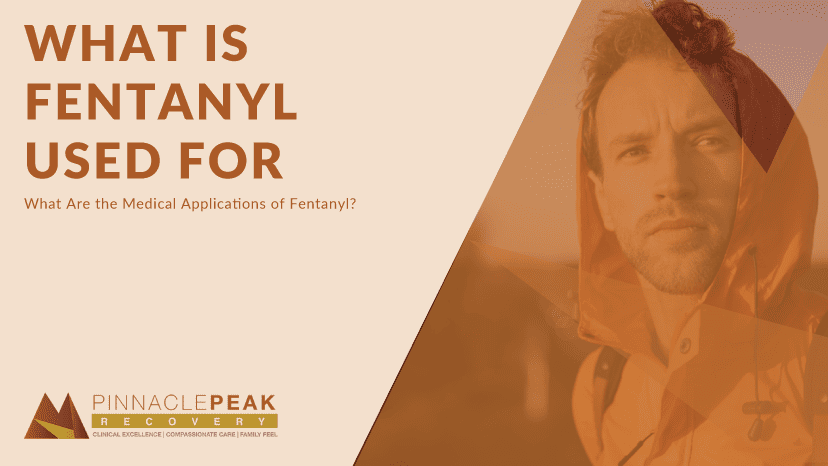The term “fentanyl” has become a bit of a buzzword in today’s news. Recently there was an internet rumor being spread like wildfire about fentanyl being put on public toilet seats in order to drug people. Even though this information was false, it still spread around quite a bit. Rest assured, you can’t be drugged just by sitting on some fentanyl. So what is fentanyl used for?
Fentanyl is a drug that is primarily used in helping manage pain in patients. It can also be used for anesthetic purposes during surgeries. There are people, however, who do take fentanyl outside of medical advice, and its uses and effects there can differ a lot, too.
Our team here at Pinnacle Peak Recovery is dedicated to helping continue to answer the questions of our community. We work hard to have a family-feel-based approach to recovery, to make all feel welcome and at home, and we extend this to our community members as well. That’s why we put out blogs like this to help people be more informed about substance use as well as the medicines they or a loved one are putting into their bodies. Today we’re going to take a look at what fentanyl does and explain more about its uses.
What Are the Medical Applications of Fentanyl?
Opioids like fentanyl have been used in modern medicine for many years. Despite the concern regarding the misuse of opioids in our country, this doesn’t negate the helpfulness of this type of medication for many people.
Let’s talk more about the uses of fentanyl and how it differs from other forms of opioids.
Fentanyl in Pain Management - Cancer Care, Chronic Pain, and More
Opioids as a whole are already primarily used for pain management. Fentanyl, however, is much more potent than the average opioid. It is a synthetic opioid that is known to be 50 times stronger than your average opioid. This is why it’s primarily utilized for severe pain, or for those going through cancer treatment. In most situations, it’s not prescribed on its own, but rather for situations of “breakthrough pain” which is pain that happens suddenly, despite other forms of pain management being used regularly.
Fentanyl in Anesthesia: Role in Surgical Procedures
Fentanyl is also one of many different kinds of sedatives that are used during surgeries. It’s most commonly used by being added to a drip. The form of fentanyl used for surgeries would never be prescribed to a patient and is only utilized in a hospital setting.

Is the Recreational Use of Fentanyl Dangerous?
Despite the fact that fentanyl is used in approved healthcare settings, or on a prescription basis, this doesn’t make the use of it outside of medical guidance safe. This is true with nearly every medication, though most of them don’t have the same risk of dangerous side effects as fentanyl.
The misuse of fentanyl can occur in many ways. If you take too many doses at once, drink alcohol while on a fentanyl prescription, seek out fentanyl from non-medical sources, and more.
In recent years, the use of fentanyl has become quite a keyword in communities across the United States. While it is important that people are further discussing fentanyl, what it is, and what to look out for -- it’s also important to note that not everything we see on social media from random sources is always accurate.
So where are the most significant risks with fentanyl in the world of substance use?
How Drug Dealers Use Fentanyl
Due to its synthetic nature, fentanyl is often a cheap product that drug dealers can get their hands on. If they’re not selling it outright, they can use it to lace other substances, most commonly things like meth, heroin, or cocaine, in order to maintain the high that the product achieves while gaining more profit than normal.
Why Are Other Narcotics Laced With Fentanyl?
One of the biggest concerns of the “opioid epidemic” revolves around fentanyl being inside other substances, usually without the person knowing about it. Why is this, though?
The term “lacing” refers to a substance being added to another substance. In the case of fentanyl, it’s commonly added to other substances due to its affordability. This allows drug dealers to spread their product thinner without losing its potency.
In fact, lacing products with fentanyl can often drastically increase their potency.
Because of this, when people take something laced with fentanyl without knowing it, they can significantly increase their risk of overdosing. When they don’t know fentanyl is present, they could take their normal dosage without realizing it would impact them much more than usual. This has been one of the most common reasons behind the spike in opioid overdoses across the country.
Thankfully, there are things you can do in the case of an overdose, but first, you need to know how to spot one. Here are some of the most common side effects of a fentanyl overdose:
- Dizziness
- Confusion
- Sudden drowsiness
- Shallow or no breathing
- Smaller pupils
- Unresponsiveness
If you suspect that you or a loved one is experiencing an overdose, don’t hesitate to call for medical help. The Good Samaritan Law here in Arizona protects people from getting into legal trouble when seeking help for an overdose. Additionally, you can use this website to locate naloxone distribution near you. Naloxone can be used to help someone who is experiencing an opioid-related overdose.
If you ever suspect that your drugs might be laced with something, it never hurts to check. Since September 2021, the use of fentanyl testing strips has been legalized in Arizona. Even if it takes you some time to find and use the strips, your life is worth it.
How Is Fentanyl Administered
The way you receive fentanyl will vary depending on your needs as well as if you get your fentanyl from a prescription or from a dealer.
When prescribed by a doctor, it’s commonly given in one of three forms: as a shot, a patch, or as a lozenge. The most common ways you’ll find fentanyl illicitly is as a powder, pills, eye droppers, or nasal sprays.

Getting Treatment For Fentanyl Use Disorder in Arizona
With Arizona seeing peak opioid dispensing rates, sitting at 66 per 100 people in some parts of the state, there’s a good chance you know someone who is either currently taking opioids or has in recent times. While there isn’t anything inherently wrong with needing pain medication, with the right circumstances it can lead to dependence.
If you or a loved one is managing a fentanyl use disorder, and you want to take that first step toward recovery, Pinnacle Peak is here to help. We have everything from detox to inpatient and outpatient programs to help get you started on your recovery journey from fentanyl use disorder. We’ve worked hard to find a treatment plan that works well for our patients. We have one we’re so certain of that if you complete our Proven Process and you relapse within the first year, we’ll bring you back for 30 days of treatment at no cost to you.
Recovery isn't always a straight line, but it is always possible. Our team here at Pinnaclek Peak Recovery is ready to help whenever you're ready. You give us a call anytime at 480-787-2409 with any questions you may have.
Want To Conquer Fentanyl Use Disorder and Reclaim Your Life? Call Us Today!
FAQs
Where does fentanyl come from?
Fentanyl is a synthetic opioid.
What is the benefit of fentanyl?
When taken as prescribed, fentanyl is beneficial for managing severe pain. It is also commonly used to assist with sedation for surgeries.

